Tech Tuesday : Porsche Fuel System Testing

We have been playing around with our shop 997.2TT trying to find the limits of the stock low pressure fuel system as well as some alternative fuel testing utilizing some of our more recent fuel table discoveries. Many of the discoveries for the 997.2TT will relate to the 991TT both in hardware limitations as well as advancement of Cobb software and the Accessport.
We started testing ethanol blends a bit while at Pikes Peak with the 991TT. We found we were easily capable of running a blend of 20%-30% Ethanol without issue. We took all of the data we collected from the Pikes Peak winning 991TT as well as the 2nd place 997.2TT and applied some of it towards our fuel system testing which was done at our COBB SoCal facility.
Buckle up if you like data, we’re about to serve up a whole platter-full! We at Cobb are always striving to make our product better and supply information to the masses in an effort to help advance the aftermarket as a whole. We are in the business to make cars fast and we do a great job at it! That said, we wouldn’t be where we are today with out the aftermarket hard part manufacturers, so please take this data for what it is and use it as you need!
Stock Fuel System Setup:
Here is a quick breakdown of how the fuel system operates in stock form. The 997.2TT is a returnless fuel system with two sucking jet pumps which pull fuel from the bottom of the tank and deliver them to the upper fuel pump chamber where the low pressure fuel feed pumps live. The two low pressure feed pumps are controlled individually. Pump number one is controlled by PWM from the DME/ECU to a fuel pump controller. This fuel pump controller regulates pump number one based on fuel demand sent from the ECU(between 6-14 amps based on voltage control). Pump number two is either full on or full off without regulation from a fuel pump controller. Pump two is simply switched on when the ecu requests fuel flow of more than 110 liters per hour(lph). Below is the wiring diagram for the relays, pumps, and low pressure fuel pump control unit.
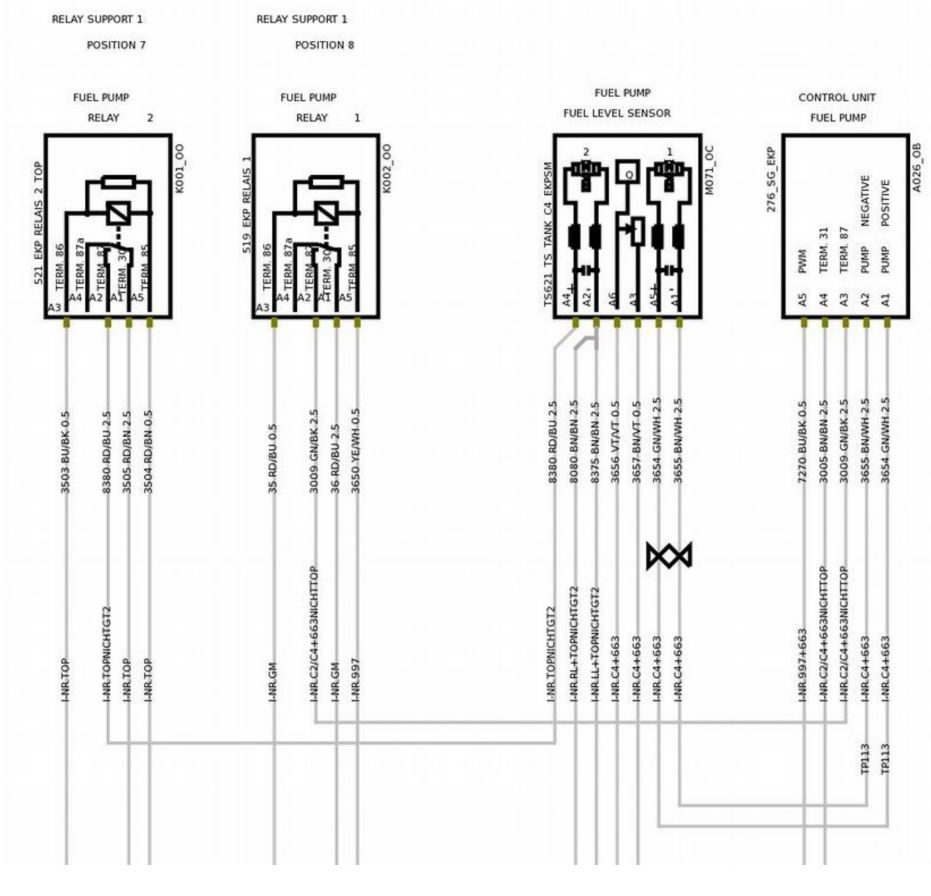
Both of these pumps go directly into the fuel pressure regulator which is also contained at the top of the upper fuel pump chamber. The stock regulator is strictly mechanical and is a 5bar(72.5psi) regulator. Once this fuel pressure is achieved the excess fuel is dumped back into the chamber. Another thing to note is that the regulator does not have a vacuum reference like the 996TT or 997.1TT to raise and lower fuel pressure. It simply wants to keep 72.5psi at all times.
Testing Low Pressure Fuel Flow:
We began by testing the low pressure fuel system flow in liters per hour. I wanted to know exactly how much fuel would flow from the stock low pressure pumps through the stock pressure regulator and fuel lines, which would ultimately end up at the feed for the cam driven high pressure pump. This was done assuming we wanted to know what the output is when the pumps are under full load, meaning both low pressure pumps running at 14 volts. To do this we wired up the two pumps directly to the battery along with a Snap On battery tender to maintain 14.2 volts. I disconnected the low pressure fuel feed line in the back near the high pressure pump and fed that into a measured receptacle. We found that under full load the low pressure fuel system was delivering ~410lph to the high pressure pump (2.50gal of fuel was delivered in 82.75 seconds or 411.70lph)
We also tested the flow of a single pump independent of the entire system. Our friends at BBi Autosport supplied the stock pump so we didn’t have to Frankenstein our basket to remove it. Tested at 14.2v the uninhibited single pump flowed ~235lph(236.95lph), at 11.5v the pump flowed ~210lph(209.65lph). Assuming both pumps are identical based on the part number we can deduce that two uninhibited pumps would produce ~470lph at 14.2v. However, since they have to pump fuel through the fuel filter, pressure regulator (72.5psi) and the remaining fuel line to the rear of the car there is a flow loss of ~60lph. Remember, the measured output was ~410lph in the previous test.
Calculating Max Wheel Power Stock Low Pressure Fuel Supply Can Support:
Math gets a bit intense here so if you’re here just for results please skip to the bottom of this section for bolded results. And for brevity we will do this example just for gasoline. There is a log here containing all of the data used in this section.
For this calculation we need to know the following: specific gravity of gasoline, max lbs/hour flow of the low pressure system on gasoline, airflow, AFR, and horsepower. All of which can be deduced from our test above, datalogs, and the correlating dyno plot.
There are alternate routes, units, etc. to achieve the same results; this is just how we chose to do it. To begin we will want to calculate the fuel mass being injected per unit of time. To do this we can use our logged parameter of air mass and AFR to find fuel mass. Porsche 997.2TT measures air mass in mg/stroke per bank so we will first need to multiply that value by 2(2 banks) and then convert that into g/sec.

That will give you your mass of air in g/s at one particular point. You can now use that air mass along with actual AFR to calculate fuel mass. Since AFR is simply the ratio of air to fuel this is rather simple. I also took the average AFR of both banks.

Now that we have calculated our fuel mass in g/s we will convert this to lbs/hr.

Using this and wheel horsepower we can now calculate the specific fuel consumption (SFC).
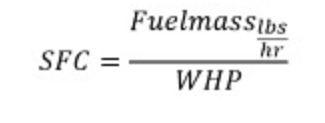
With SFC we can almost calculate the max WHP that can be made from from the stock low pressure pumps at 14.2v, but first we will need to convert the lph flow of the pump test above into lbs/hr using gasoline. This is where the specific gravity comes into play. Specific gravity is a ratio of the density of one substance compared to a control substance. That control substance is generally always water. We will use a specific gravity of .74 for gasoline and assume that 1 gallon of water weighs 8.334lbs. From this we can find the weight of gasoline per gallon. We will also convert liters to gallons at this stage, because our initial test was performed in LPH.

Finally we have everything we need to determine the max wheel horsepower the low pressure pumps can support. Using SFC we calculated from before and substituting in the lbs per hour of gas the pumps flow we can find that max WHP.
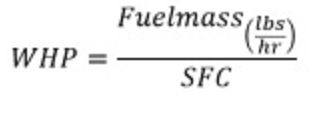
What does this all look like with actual values? Let us choose one RPM to work with from the datalog. I will choose 5920 RPM. At that RPM all these values are gathered:
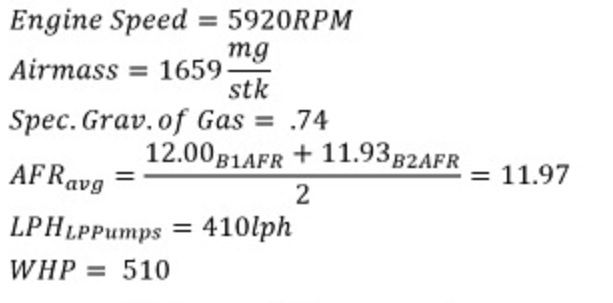
Air mass Calculation:

Fuel Mass Calculation:

Then to lbs/hr:

Calculate SFC – Keep in mind this SFC will be a bit different as we are using it for wheel HP and not crank HP. It will also likely change some under more load.

Converting LPH to lbs/hr for the low pressure pumps for gasoline:

Finally using the calculated SFC and lbs/hr to find max WHP:

In that example using our measurements obtained from datalogs, dyno runs, and fuel pump testing we have concluded that at 4920RPM the low pressure fuel system should be able to support 785.9WHP at 14.2 volts. The datalog here includes data collected from the car as well as dyno data that has been ported over and many custom calculations I made in this process.
Using all of the data gathered it is theoretical that the stock 997.2 low pressure fuel system at 14.2v can support 762.3whp at 6496RPM. This however doesn’t mean the car is capable of making that on the stock fuel system. The voltage to the pumps supplied by the relays has not yet been verified. There are also many factors that are yet to be tested with the high pressure system which is exponentially more difficult to test.
Empirical Fuel Pressure Testing of the Low Pressure Fuel System:
While we had the car on the dyno we hooked up our fuel pressure sensor to the low pressure side of the fuel system in order to gather real world data on the operation of the low side pumps and the impact on fuel pressure under heavy load. Here is a data log with low side fuel pressure added.
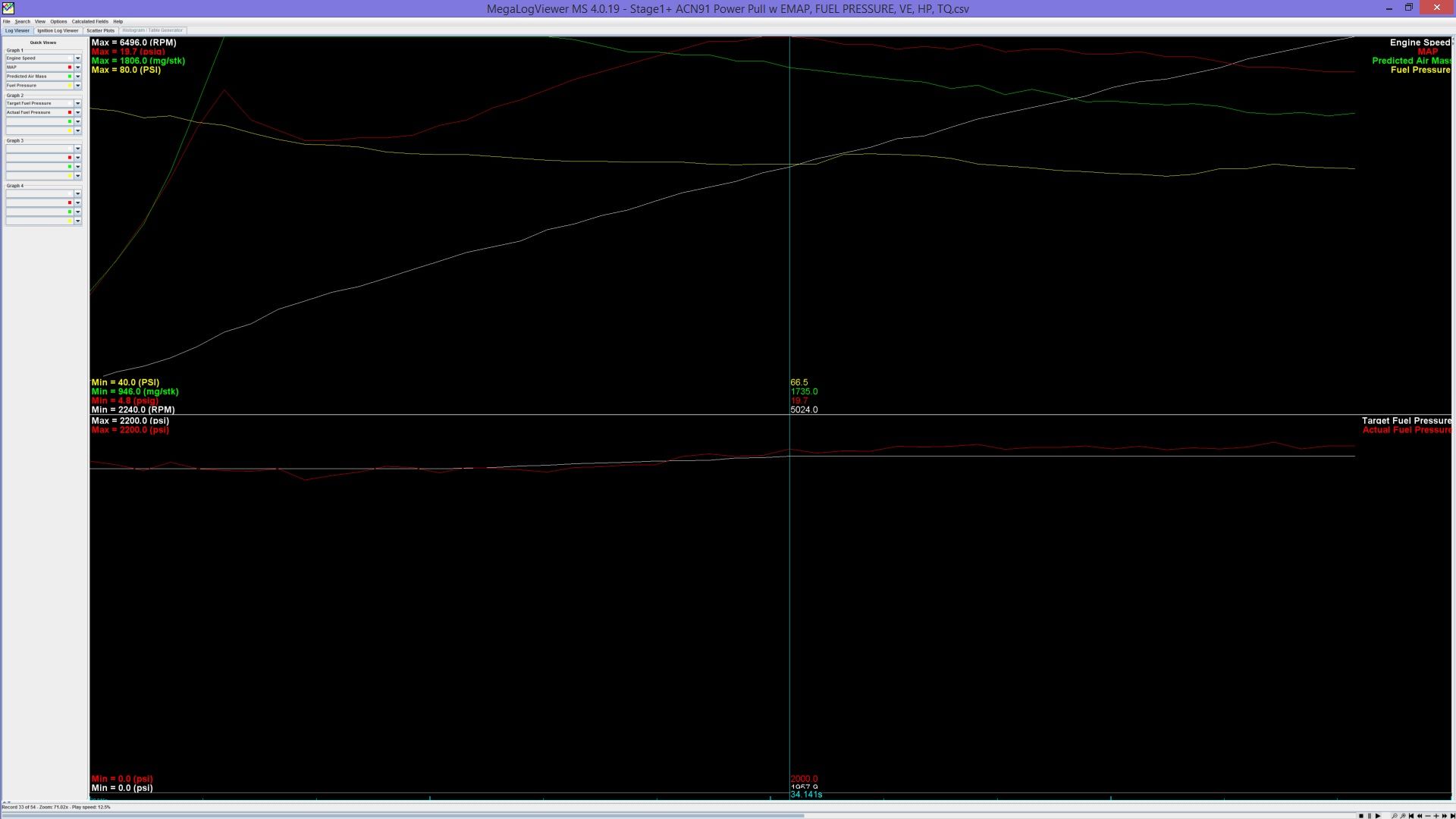
RPM(Top White), MAP(Top Red), Predicited Air Mass (Green), Low Side Fuel Pressure(Yellow), High Side Fuel Pressure Actual(Bottom Red), High Side Fuel Pressure Target(Bottom White) I have also uploaded this loghere at datazap for you guys to play with if you wish.
You can see the low side fuel pressure is steadily dropping from the onset of boost to redline. The pressure starts out at the base of ~72.5psi but as the load increase and fuel demand rises the low side fuel pressure falls. Since we found out in the last section that the low side can supply enough fuel for significantly more power at 14.2v it leads me to believe that the voltage reaching the pumps via the relays and ECU control is substantially less than that. We will conduct more testing with the pumps hardwired and post up further results as well as using an external source to datalog the voltage at the pumps in stock form to see what they are getting.
Ethanol Testing:
Mitch has recently uncovered and added some very useful tables in the ecu to make easy ethanol mixture calibrations. These tables will remain internal until they have been thoroughly tested. But for the most part they allow us to adjust fuel based on a constant for stoichiometric AFR. What this simply does is allows us to change the base stoich for the fuel we are using. Stoich for Gasoline is approx.14.7 parts air to 1 part fuel. Ethanol is 9 parts fuel to 1 part air. Knowing this we can approximate the stoich ratio of any blends in between. For instance E40 would be 14.7(.6) x 9(.4) = 12.42 parts fuel to 1 part air. Using this we can make broad adjustments based on ethanol percentages.
We also now have full control over fuel corrections which we use to fine tune the mixture after the broad stoich adjustment has been made. So far we have successfully tested many mixtures up to E55! With good gains throughout on a 100% bone stock car!
Below is a dyno chart comparing our OTS Stage1 tune on ACN91 to one of our E40 test.
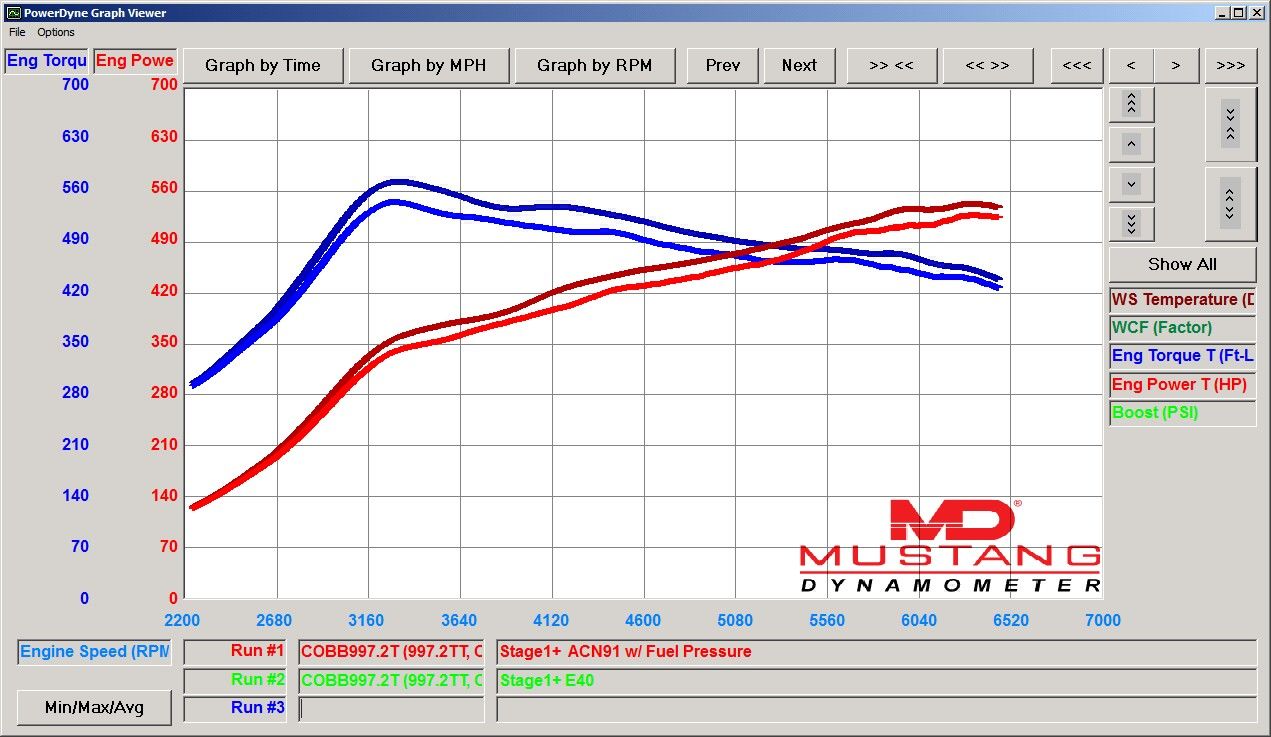
We will continue our testing with ethanol as well as some further low pressure fuel pump testing in the upcoming weeks, stay tuned in as we will definitely be sharing additional data as it becomes available!
Jon Hebbeln – COBB Tuning Porsche R&D Calibrator

Leave a Reply